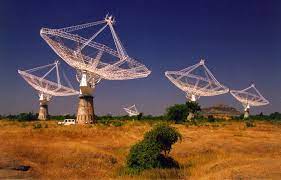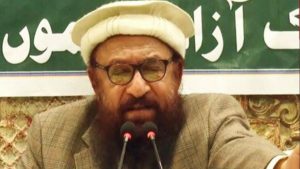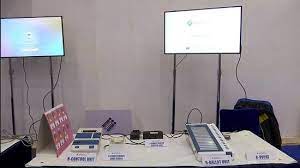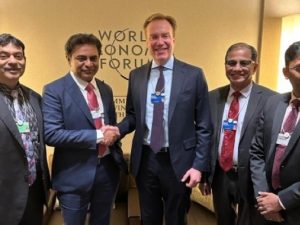Today’s Current Affairs: 19th January 2023 for UPSC IAS exams, State PSC exams, SSC CGL, State SSC, RRB, Railways, Banking Exam & IBPS, etc
Table of Contents
Giant Metrewave Radio Telescope : Detected Atomic Hydrogen From a Far-Away Galaxy

A radio signal originating from atomic hydrogen in an extremely distant galaxy was detected by the Giant Metrewave Radio Telescope (GMRT).
- Astronomers from McGill University in Canada and the Indian Institute of Science (IISc) in Bengaluru have used data from the telescope to detect atomic hydrogen.
- Giant Metrewave Radio Telescope is a low-frequency radio telescope that helps investigate various radio astrophysical problems ranging from nearby solar systems to the edge of the observable universe.
- It is operated by the National Centre for Radio Astrophysics(NCRA), a part of the Tata Institute of Fundamental Research, Mumbai.
Atomic Hydrogen:
- Atomic hydrogen is the basic fuel required for star formation in a galaxy.
- When hot ionised gas from the surrounding medium of a galaxy falls onto the universe, the gas cools and forms atomic hydrogen.
- This atomic hydrogen then becomes molecular hydrogen and eventually leads to the formation of stars.
- Atomic hydrogen emits radio waves of 21 cm wavelength, which helps in the direct tracing of the atomic gas content in nearby and distant galaxies.
Abdul Rehman Makki : Listed As a Global Terrorist By UNSC

Abdul Rehman Makki is a Pakistan-based terrorist who was recently listed as a global terrorist by the United Nations Security Council (UNSC) under its ISIL (Daesh) and Al-Qaeda Sanctions Committee.
- He has been sanctioned based on his links to the 2000 Red Fort attack and the 26/11 Mumbai terror attacks.
- Makki is the brother-in-law of Lashkar leader and founder Hafiz Saeed, who was the mastermind of the 26/11 attacks.
- In 2022, India and the United States jointly proposed listing Makki under the United Nations Security Council’s Al-Qaeda and ISIL Sanctions Committee, however, China rejected the proposal by putting a “technical hold” on it.
- Makki’s listing as a global terrorist could lead to financial sanctions on Makki and his associates.
- It puts pressure on Pakistan to take action against those involved in terrorist activities and could lead to further isolation on the international stage.
- Makki’s listing highlights Pakistan’s role as a breeding ground for terrorist groups and its failure to take action against them.
Giving To Amplify Earth Action (GAEA) Initiative:

The World Economic Forum, in partnership with over 45 organizations, has launched the Giving to Amplify Earth Action (GAEA) initiative.
- The goal of GAEA is to fund and grow new and existing public, private, and philanthropic partnerships (PPPPs) to unlock the $3 trillion of financing needed each year to reach net zero, reverse nature loss, and restore biodiversity by 2050.
- GAEA’s growing body of philanthropic partners includes organizations such as the African Climate Foundation, Bezos Earth Fund, and the Rockefeller Foundation.
- Over the next 12 months, GAEA will work with these partners and McKinsey Sustainability as a knowledge partner, to build momentum around three clear objectives:
- Convene leaders from the public, private, and philanthropic sectors to identify and target climate and nature solutions where they are best positioned to play a catalytic role.
- Pilot and refine funding models that can support PPPP interventions.
- Scale up funding for targeted climate and nature solutions, leveraging philanthropy as a catalyst for attracting and deploying other forms of financing.
Evidence Of Solitary Waves Around Mars:

Indian Institute of Geomagnetism (IIG), an autonomous institute of the Department of Science and Technology (DST) has found evidence of “solitary waves” in the weak magnetic field around Mars for the first time.
- Scientists used high-resolution electric field data from NASA’s MAVEN spacecraft to make the discovery of solitary waves.
- Unlike Earth, the planet Mars does not have any intrinsic magnetic field. This allows the high-speed solar wind to interact directly with the Mars atmosphere, like an obstacle in flow.
- It has been suggested that even in a weak and thin magnetosphere as that of Mars, frequent occurrences of solitary waves can be observed.
- However, despite several missions to Mars, the presence of solitary waves in the Martian magnetosphere has never been reported earlier.
- The waves were found mostly in the morning and evening on Mars, at altitudes of 1000-3500 km, and their exact cause is still unknown.
Solitary Waves:
- Solitary waves are the distinct electric field fluctuations (bipolar or monopolar) that follow constant amplitude-phase relations.
- Their shape and size are less affected during their propagation.
State Finances: A Study Of Budgets Of 2022-23

The Reserve Bank of India (RBI) has released a report stating that the Gross Fiscal Deficit (GFD) of states is expected to decrease to 3.4% of Gross Domestic Product (GDP) in 2022-23, from 4.1% in 2020-21.
- This is due to a broad-based economic recovery and an increase in revenue collections.
- The report titled “State Finances: A Study of Budgets of 2022-23” is a comprehensive analysis of the financial position of the Indian states, including the trends and challenges in their revenue and expenditure.
Finding of the Report:
- According to the RBI report, states’ debt is expected to decrease to 29.5% of GDP in 2022-23, compared to 31.1% in 2020-21.
- The report also highlights that this is still higher than the 20% recommended by the Fiscal Responsibility and Budget Management (FRBM) Review Committee in 2018.
- States are anticipating an increase in non-tax revenue, which is generated from sources such as fees, fines, and royalties.
- This increase is likely to be driven by revenue from industries and general services.
- The report notes that states are expecting to see an increase in revenue from various sources such as State GST, excise taxes, and sales taxes in the 2022-2023 fiscal year.
Remote Voting For Migrants:

The Election Commission of India (ECI) has proposed a new Remote Electronic Voting Machine (RVM), which will allow domestic migrants to vote in national and regional elections.
- The EC proposed using this in a State Assembly election as a pilot so internal migrants within a state can cast their ballots.
- Hearing a petition on the alleged denial of voting opportunities to migrants, the Supreme Court (SC) had in 2015 directed the EC to explore options for remote voting.
- There are nearly 10 million migrant workers, which is for the unorganised sector, registered with the government’s e-SHRAM portal. If the remote voting project is implemented, it will have far reaching ramifications.
- RVM is a modified version of the existing Electronic Voting Machine (EVM).
- The special remote polling booths would be set up in different states when elections are on in the home state of migrants.
- The RVM can handle multiple constituencies from a single remote polling booth.
- For this, instead of a fixed ballot paper sheet, the machine has been modified to have an electronic dynamic ballot display which will present different candidate lists corresponding to the constituency number of the voter read by a constituency card reader.
- The system would have a device similar to the so voters can verify their votes.
Advance Medical Directive:

A Constitution bench of the Supreme Court (SC) questioned the utility of executing an advanced medical directive in India when a person is anyway free to refuse invasive treatment and accept death.
Advance Medical Directive/Living will:
- It is a document prescribing a person’s wishes regarding the medical treatment the person would want if he/she was unable to share his/her wishes or not in a position to make an informed decision by reason of being unconscious or in a coma.
- Supreme Court in Common Cause vs. Union of India, 2018 recognised that a terminally-ill patient or a person in persistent vegetative state can execute an “advance medical directive” or a “living will ” to refuse medical treatment and gave sanction to passive euthanasia and living will/advance directives.
- The court also laid down principles relating to the procedure for execution of living will.
- An adult who is of a sound and healthy mind and in a position to communicate, relate and comprehend the purpose and consequences of executing the document can draw up an Advance Medical Directive/Living Will
- It must be voluntary.
- It should be in writing and should clearly state as to when medical treatment may be withdrawn or if specific medical treatment that will have the effect of delaying the process of death should be given.
- Instructions must be absolutely clear and unambiguous.
- It should mention whether the patient may revoke the instructions/authority at any time.
- It should specify the name of a guardian or close relative who, in the event of the patient becoming incapable of taking decision at the relevant time, will be authorized to give consent to refuse or withdraw medical treatment
- If there is more than one valid Advance Directive, the most recently signed Advance Directive will be considered as the last expression of the patient‘s wishes and will be implemented.
Greater Scaup : Species Of Duck Sighted In Loktak Lake

A rare species of duck, Greater Scaup, was recently sighted in Loktak lake in Manipur’s Bishnupur district after a gap of over 90 years.
- The Greater scaup is locally known as Sadangman.
- It is a medium-sized diving duck species that belongs to the family of Anatidae.
- The greater scaup species is distributed in Asia, Europe, the United States and Canada. It is a rare visitor to the Indian Subcontinent.
- The breeding scaup inhabits shallow, freshwater lakes, pools and rivers with grassy shorelines.
- The greater scaup species are highly migratory, breeding near arctic regions and migrating to the warmer south from August onwards.
- Conservation status: IUCN Red List: Least concern
Grameen Udyami Scheme:

Union Minister of State for Skill Development & Entrepreneurship will attend the felicitation ceremony of over 200 tribal women who have completed training under Phase 3 of the Grameen Udyami Scheme in Jharkhand.
- Grameen Udyami Scheme was launched to augment skill training in tribal communities for inclusive and sustainable growth.
- It is funded by the National Skill Development Corporation.
- The project is being implemented in Maharashtra, Rajasthan, Chhattisgarh, Madhya Pradesh, Jharkhand, and Gujarat.
- It is implemented under the Sansadiya Sankul Pariyojana to expand the rural/local economy, enhance employment opportunities, reduce forced migration and also lead to the conservation of natural resources.
- The National Skill Development Corporation (NSDC) is a non-profit public limited company established on July 31, 2008, under Section 25 of the Companies Act, 1956.
- The Ministry of Finance established it as a Public Private Partnership (PPP) model.
- The Government of India, through the Ministry of Skill Development and Entrepreneurship (MSDE), owns 49% of NSDC, while the private sector owns the remaining 51%.
Indo-Russian Joint Venture Begins Manufacturing AK-203 Assault Rifles In U.P:

The Indo-Russian Rifles Private Limited (IRRPL), has started producing AK-203 Kalashnikov assault rifles at Korwa in Uttar Pradesh.
- The AK-203 rifles are manufactured in a joint venture between India and Russia.
- These are high-quality, convenient and modern small arms.
- This model combines excellent ergonomics, adaptability to different shooters and high-performance characteristics, it is one of the best assault rifles in the world.
- The joint venture plans to ensure 100% localisation of the production of AK-203 rifles in India
Indo-Russian Rifles Private Limited (IRRPL):
- The IRRPL was set up in 2019 jointly between erstwhile OFB [now Advanced Weapons and Equipment India Limited (AWEIL) and Munitions India Limited (MIL)] of India and Rosoboronexport and Kalashnikov of Russia.
Hyderabad: Center For The Fourth Industrial Revolution

The World Economic Forum (WEF) has chosen Hyderabad, Telangana for establishing its Center for the Fourth Industrial Revolution (C4IR).
- The C4IR Telangana will be an autonomous, non-profit organisation with a thematic focus on healthcare and life sciences.
- It is characterised by the use of technology to blur the boundaries between the digital, physical, and biological worlds, and is driven by data.
- Key technologies include cloud computing, big data, autonomous robots, cybersecurity, simulation, additive manufacturing, and the internet of things (IoT).
- The term 4IR was coined by Klaus Schwab, executive chairperson of the WEF, in 2016.
- The pacemaker is a near-perfect example of the ongoing fourth industrial revolution (4IR).
- The four wireless sensors of the pacemaker monitor vitals such as temperature, oxygen levels and the heart’s electrical activity.
- The device then analyses the vitals and decides when to pace the heart and at what rate.
- Doctors can wirelessly access the information on a tablet or smartphone.
- Xenobots, which are less than a millimetre long, are known to be the first living robot, were created in 2020 from the stem cells of the African clawed frog and can be programmed using artificial intelligence.
- It has a reproductive ability demonstrated in October 2021 by a team of US scientists.
- When the researchers put the xenobots into a petri dish, they were able to gather hundreds of tiny stem cells inside their mouths and create new xenobots a few days later.
- Once perfected, xenobots could be useful for tasks like cleaning up microplastics and regrowing or replacing dead cells and tissues inside human bodies.
- The sensors monitor odour levels in railway toilets, check if the doors are safely closed, avoid fire outbreaks and stop unauthorised travel using CCTV cameras with face recognition capabilities, among other technologies.




